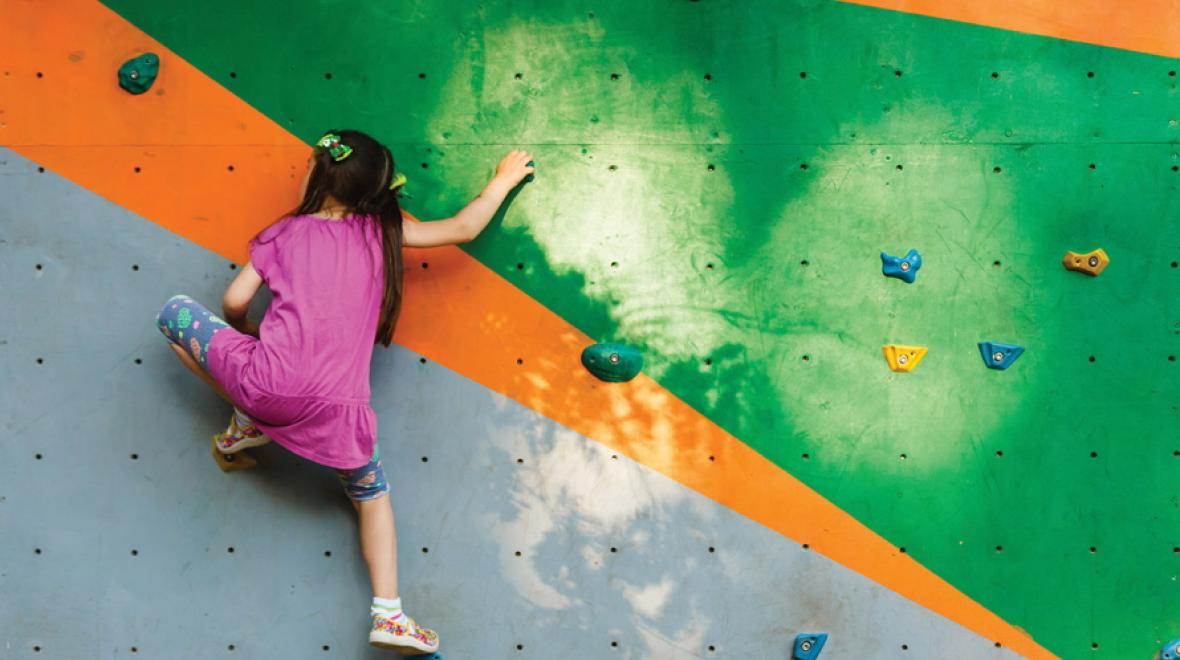
Editor's note: This article was sponsored by KidsQuest Children’s Museum.
With everything going on right now — COVID-19 and monkeypox, climate change and gun violence, just for starters — few parents are asking the question “Is my child getting enough risk?” But maybe we should be. Because it turns out that a healthy dose of risk in child’s play — the kind where there is a small but real chance of failure or of even getting hurt — is, well, healthy.
Safe assessment
“Risk is a situation involving exposure to danger or perceived danger,” says Jamie Bonnett, director of education for KidsQuest Children’s Museum in Bellevue. Bonnett has a professional interest in the way kids play, and she’s concerned about how much it has changed in just a couple of generations. Many of today’s parents are appalled by things that used to be considered normal childhood play: biking around the neighborhood unsupervised, building forts with real tools and getting creative with playground equipment (e.g., climbing up the slide, standing up in swings). Even the equipment itself has changed, as swing sets, merry-go-rounds and seesaws are conspicuously missing from new playgrounds. These examples of old-school “bad parenting” are presented as recklessness. But in this case, the baby boomers may have been right.
There’s no such thing as zero risk. There are only tradeoffs between risks, and science is increasingly certain that in the pursuit of absolute safety, our society is incurring other risks that may outweigh the potential dangers of physical play.
“It’s all wrapped up in imagination and social-emotional learning. It’s a daisy chain of skills. Whether they succeed or fail, the package of things that you get along with taking risks is what’s so critical,” says KidsQuest CEO Putter Bert. “We tend to focus on the one little dot of danger, dwelling on the negative and not on the package of benefits.”
Risk supports children’s physical, mental and social development.
“If we don’t engage in and take risks, what will be left?” asks Bert. “The alternative is so much worse.”
Absolute safety in play is associated with sedentary behavior and its related health impacts, such as obesity and decreased motor skills. Less obviously, playing too safely is associated with anxiety and phobias, and even with decreased social skills. The experiences of trying something scary and succeeding and trying again after failure help build confidence and self-esteem.

Safe risk
Bike helmets and swimming pool lifeguards have undoubtedly saved lives, and everyone would agree that children should never be put in life-threatening situations. But there are myriad benefits to taking smaller risks, and these benefits are worth the occasional skinned knee. In fact, the skinned knee itself has benefits — including greater physical safety.
Though it would seem counterintuitive, children who engage in risky physical activity are less likely to be injured than those who have been sheltered from such play and thus have not developed the gross motor skills or learned to gauge their own abilities to navigate challenging situations.
“They are actually safer because they’ve practiced emotional regulation, trial and error, and impulse control,” explains Bonnett. Studies have shown overall positive effects of engaging in risky physical play on a variety of health indicators and behaviors. One of the biggest benefits to children is that they learn how to recognize and measure their own tolerance for risk.
Playing in the ‘Danger Zone’
“Our mission is to give tools to everybody — adults and children. Risk and danger, those are tools. There is a whole cornucopia of things we learn from a single risky action,” says Bert.
Bonnett adds, “We’ve always carried safe risk through the museum, in the programming, in the exhibits we’ve built, and in the activities that we set for parents and children to engage in.” But that safe risk is increasingly absent in the rest of children’s lives. Bert recounts a story about one school-age child who apologized after touching a car door — she had been trained to avoid touching germy surfaces. Another announced she had never been near enough to a fire to feel its heat.
This year, KidsQuest addressed the growing need for controlled exposure to danger with its new “Danger Zone” workshops. Taking inspiration from Gever Tulley’s book “50 Dangerous Things (You Should Let Your Children Do),” these workshops give children a chance to test their limits with fire, pocketknives, ladders and rocks. (Tinker and engineering workshops this fall will offer more safe risk opportunities.)
The trick to making this training in terror fun and feasible is called scaffolding.
“Scaffolding is setting up a space in which adults can support the learning, but not do the learning,” explains Bonnett. So, you don’t offer free play on ladders. Instead, you start by talking about how to climb up and down the ladder, and what to do if you start to feel afraid. (For example: Take deep breaths, then think carefully about your next step.) If a child gets stuck when practicing on their own, you coach them from the ground, or at most, by putting a hand on their back while talking them through the steps. But you don’t swoop in and pluck the child off the ladder. This approach keeps kids as safe as necessary, instead of as safe as possible.
“They could fall off the ladder, but the likelihood of that happening is really low because of how we’ve set it up and how we’ve prepared them,” says Bonnett.
Indications of this sort of intentional scaffolding are evident throughout the museum’s exhibits. For example, tall climbing structures are constructed to exclude parents, encouraging kids to challenge themselves in two ways: climbing high above the ground and separating from their parents.
“It’s building self-confidence for that child. It’s allowing them to see How far can I go before I start to feel a little butterfly in my stomach? Those are feelings we want children to be aware of and then know what to do with them,” says Bonnett. She says that process helps them learn self-regulation.
Exhibits are also designed for nonphysical forms of risk as well.
“The other part of risk is trial and error — taking the risk to make a mistake. So much of schooling is risk-avoidant to ensure the best outcome,” says Bonnett. “It’s important to practice trial and error because it is really important to learn what to do with failure.” Failing and then summoning the courage to try again is the very definition of resilience, and the only way to gain it is to practice it. The museum’s interactive art and play spaces include materials but not instructions, encouraging children to come up with and test their own solutions, even if they don’t work out.
Personal risk
“Risk is personal,” says Bert. “Tasting a new food, for some people, is a giant risk.” Everyone has their own boundaries, and that’s as true for parents as it is for kids. That’s why KidsQuest offers programs for adults as well as options for kids’ workshops with and without parent participation. Sometimes, kids need to be away from their parents before they will start to pay attention to their own instincts. But sometimes parents need to see their kids successfully taking risks to realize that the fear is their own. “Then it’s about the adults’ self-regulation,” says Bert.
She adds, “I think adults have made children more scared. Not only do we want to encourage children to take risks, but we’re going to need to do that in concert with their adults.” Adults teach children to be afraid when we constantly warn, “Don’t do that, it’s dangerous,” and we can transmit our fears when we talk to kids about the big issues happening in the world right now. While it is important to talk to children about serious topics such as the COVID-19 pandemic, climate change and gun violence, Bonnett warns, “Be aware of children’s capacity for understanding to ensure you’re not placing an undue burden of fear on them.”
You should also avoid the urge to push your children to take risks — forcing them beyond their own comfort zone is as dangerous as overprotection. Instead, the goal is to eliminate boundaries and allow children to discover their own tolerance for risk. Parents can practice the same scaffolding that the museum uses. So, instead of banning your child from the kitchen and childproofing your cabinets, teach your child knife skills and how to safely use the stove. Then, supervise them while they make breakfast themselves. More often than not, they’ll succeed. Try not to freak out if they cut themselves or break a dish; trial and error is a healthy and necessary part of the process.
Managing your fear for your children can be stressful, especially when things don’t work out perfectly.
“We know that play is a stress reducer, not only for children but for adults,” says Bonnett. So, when everything going on right now starts to get to you, go outside — or head to the museum! — to play.
|
Sponsored by: |

|











